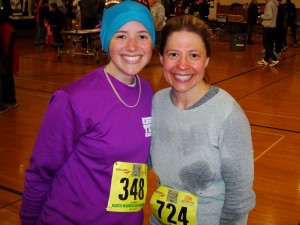Overdressed in Kenosha
This weekend marked my first longish run post-Boston marathon, and I ran the Kenosha half-marathon in nearby Kenosha, WI, just on the other side of the Illinois border. The race was interesting for a variety of reasons—in no small part because I got there late and started 10 minutes behind everyone (including the police swag car), so I got to see a lot of different people as I caught up to the larger crowd. What I was most surprised about, however, was not the undulating course (which I was not expecting) or the Kenoshan scenery (pretty, as advertised) but what people were wearing for the race. Translation: I can’t believe how overdressed people were.
Consider this post a PSA on “how to dress for the weather” when embarking on a run.
I’ve always heard to “dress as though it’s 20 degrees warmer” when dressing for a run (though there may be some concessions to that when it’s really, really cold outside). As best as I can understand, the 20 degree rule takes into consideration the fact that you’ll warm up when you’re running, despite the weather conditions. 50 won’t feel like 50; it’ll feel like 70. And ungodly concentrations of humidity can further exacerbate the weather, making 70 with 100% humidity feel a WHOLE lot hotter, probably upper 80s/90+. Some folks will even go so far to assert that you should feel just slightly chilly outside, in your running clothes, before you get movin’.
I know some people are “always cold,” or “always hot,” or something in between, so I guess those anomalies would have to plan accordingly. What blew me away at Kenosha, though, was that at the 7 a.m. start, it was already about 60 or so, very sunny, and at times, gusts of wind. In spite of these favorable (if not warm) conditions, I can’t tell you how many athletes I saw donning long-sleeve shirts, gloves, ear-warmers, hats, or long tights—stuff that I wear when it’s closer to <30 outside.
I can’t imagine that Kenosha is much hotter than Chicago, but man… it was weird. And I think what spooked me so much about it was that it reminded me of the 2007 Chicago Marathon (the hot-as-hell year). Despite how warm it was, there were throngs of runners wearing similar cold-weather wear, probably exacerbating their heat-related fatigue. It was not something I wanted to see again. And the weird thing at Kenosha was that the runners (half-marathoners or full) who were wearing tons of clothing weren’t just the folks in the back of the pack, who would be spending more time outside (and thus, subjected to the whims of the weather for a longer period of time). The overdressed folks were a cross-section of both the tortoises and the hares, the halfers and the fulls.
Knowing what to wear when running outside is worthy of care and consideration only because runners have to think about threats such as heat exhaustion, hyperthermia, hypothermia, or heat stroke, among other elements-related or elements-inflicted illnesses.
We all just have to be careful and take all these factors into consideration before trekking out on our daily jaunts.
